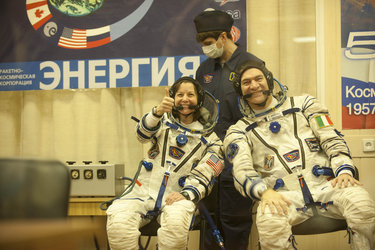Accept all cookies Accept only essential cookies See our Cookie Notice

About ESA
The European Space Agency (ESA) is Europe’s gateway to space. Its mission is to shape the development of Europe’s space capability and ensure that investment in space continues to deliver benefits to the citizens of Europe and the world.
Highlights
ESA - United space in Europe
This is ESA ESA facts Member States & Cooperating States Funding Director General Top management For Member State Delegations European vision European Space Policy ESA & EU Space Councils Responsibility & Sustainability Annual Report Calendar of meetings Corporate newsEstablishments & sites
ESA Headquarters ESA ESTEC ESA ESOC ESA ESRIN ESA EAC ESA ESAC Europe's Spaceport ESA ESEC ESA ECSAT Brussels Office Washington OfficeWorking with ESA
Business with ESA ESA Commercialisation Gateway Law at ESA Careers Cyber resilience at ESA IT at ESA Newsroom Partnerships Merchandising Licence Education Open Space Innovation Platform Integrity and Reporting Administrative Tribunal Health and SafetyMore about ESA
History ESA Historical Archives Exhibitions Publications Art & Culture ESA Merchandise Kids Diversity ESA Brand Centre ESA ChampionsLatest
Space in Member States
Find out more about space activities in our 23 Member States, and understand how ESA works together with their national agencies, institutions and organisations.
Science & Exploration
Exploring our Solar System and unlocking the secrets of the Universe
Go to topicAstronauts
Missions
Juice Euclid Webb Solar Orbiter BepiColombo Gaia ExoMars Cheops Exoplanet missions More missionsActivities
International Space Station Orion service module Gateway Concordia Caves & Pangaea BenefitsLatest
Space Safety
Protecting life and infrastructure on Earth and in orbit
Go to topicAsteroids
Asteroids and Planetary Defence Asteroid danger explained Flyeye telescope: asteroid detection Hera mission: asteroid deflection Near-Earth Object Coordination CentreSpace junk
About space debris Space debris by the numbers Space Environment Report In space refuelling, refurbishing and removingSafety from space
Clean Space ecodesign Zero Debris Technologies Space for Earth Supporting Sustainable DevelopmentApplications
Using space to benefit citizens and meet future challenges on Earth
Go to topicObserving the Earth
Observing the Earth Future EO Copernicus Meteorology Space for our climate Satellite missionsCommercialisation
ESA Commercialisation Gateway Open Space Innovation Platform Business Incubation ESA Space SolutionsLatest
Enabling & Support
Making space accessible and developing the technologies for the future
Go to topicBuilding missions
Space Engineering and Technology Test centre Laboratories Concurrent Design Facility Preparing for the future Shaping the Future Discovery and Preparation Advanced Concepts TeamSpace transportation
Space Transportation Ariane Vega Space Rider Future space transportation Boost! Europe's Spaceport Launches from Europe's Spaceport from 2012Latest

Soyuz TMA-20, MagISStra mission patch, 2010
Thank you for liking
You have already liked this page, you can only like it once!
ESA astronaut Paolo Nespoli (IT) is assigned to fly on Soyuz TMA-20 to the ISS, scheduled for December 2010, as part of the Expedition 26 crew. Expedition 27 begins with the Soyuz TMA-01M undocking in March 2011. Nespoli and his two crewmates, Roscosmos cosmonaut Dmitri Kondratyev and NASA astronaut Catherine Coleman, remain on the ISS and are joined by three new crewmembers, Andrei Borisenko, Alexander Samokutyayev and NASA's Ronald Garan (NASA), who arrive shortly after the TMA-01M undocking on TMA-21 in March 2011.
Nespoli and his crew remain on the ISS as part of the Expedition 27 crew until May/June 2011, returning their TMA-20 spacecraft.
Nespoli’s mission is called 'MagISStra', combining the Latin word 'magistra', a female teacher, with the acronym of the International Space Station. This Latin flavour not only brings in Italian culture as an ingredient of the European outlook, but also echoes the humanistic value of the mission. Since the beginning of the spaceflight adventure, humankind has pursued new frontiers to find its place in the Universe. Europe's astronaut will take with him this human sense of exploration to the Station.
The Latin word 'magister', for a male teacher, means ‘master’ in English, and also ‘expert’, ‘proficient’ or ‘fully in control’, all of which refer to the very high level of competence demanded for each astronaut mission. The name also reflects the special link with education, one of the three elements of Nespoli’s flight.
The logo shows how the human presence in space benefits people on Earth. A human figure dominates the scene, embracing the three elements around which the mission revolves: science, technology and education.
This figure, representing the astronaut himself, projects from the ISS to the planet in a sense of sharing, of bringing back applications to Earth, symbolised by three icons between the arms: a plant as scientific research, mechanical gears as technological development and a book as knowledge.
The ISS emerges from its acronym in the mission name and a sunrise seen over the crescent Earth conveys optimism about the extension of the ISS operational life to 2020. The coded text on the left, ISS/E3-3D/NESPOLI, is how the mission is identified within the Multilateral Crew Operations Panel, top-level forum for coordination and resolution of crew matters. E3 stands for the third long-duration European mission in space, and 3D refers to the ESA-developed 3D camera that Nespoli will use on the orbital complex. The six stars represent the six crew, the six months that Nespoli will stay in space and also the European character (the stars are similar to those on the EU flag). The white background symbolises the ingenuity of the human being and the willingness to learn more and search for new discoveries with an open mind.
-
CREDIT
ESA -
LICENCE
ESA Standard Licence

MagISStra mission crew during the State Commission meeting

Soyuz rocket

The first view out of the Soyuz window

Paolo Nespoli and "Cady" Coleman ready for lift off















 Germany
Germany
 Austria
Austria
 Belgium
Belgium
 Denmark
Denmark
 Spain
Spain
 Estonia
Estonia
 Finland
Finland
 France
France
 Greece
Greece
 Hungary
Hungary
 Ireland
Ireland
 Italy
Italy
 Luxembourg
Luxembourg
 Norway
Norway
 The Netherlands
The Netherlands
 Poland
Poland
 Portugal
Portugal
 Czechia
Czechia
 Romania
Romania
 United Kingdom
United Kingdom
 Slovenia
Slovenia
 Sweden
Sweden
 Switzerland
Switzerland
























